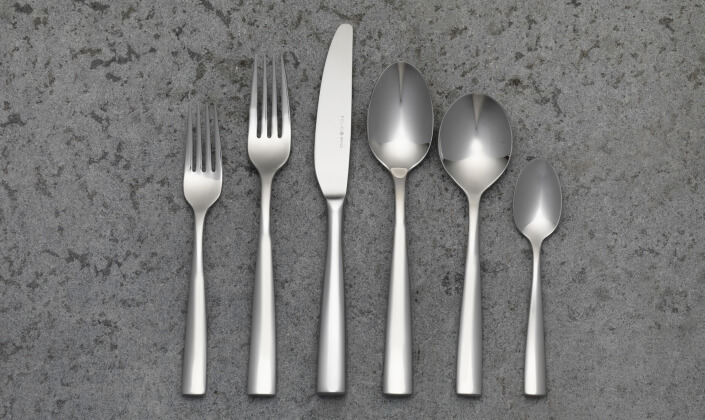Difference between Flatware and Silverware
 When you think about a restaurant or a hotel, the first thing that would come in your mind is of course, delicious picks. However, it’s the flamboyant interiors with elegant table settings that add more charm to the restaurants which in turn augment to the excitement you enjoy while having tasty food. Have you ever heard about flatware and silverware that provides the showiness to the hotel interiors with its sleek and stylish design patterns?
When you think about a restaurant or a hotel, the first thing that would come in your mind is of course, delicious picks. However, it’s the flamboyant interiors with elegant table settings that add more charm to the restaurants which in turn augment to the excitement you enjoy while having tasty food. Have you ever heard about flatware and silverware that provides the showiness to the hotel interiors with its sleek and stylish design patterns?
Then it’s time to get to know about that. Flatware and silverware are those inevitable things much needed for hotels and restaurants to provide a welcoming gesture while drawing attention from the guests.
What is a Flatware?

Image Courtesy: Steelite
Flatware refers to any set of eating utensils that are used for dining, such as forks, knives, spoons, and sometimes additional serving pieces like ladles and serving spoons. Flatware can be made from a variety of materials, including stainless steel, plastic, or even wood. Flatware can be made from a variety of materials, including stainless steel, silver, gold, and plastic.
The uses of flatware depend on the specific utensil. Here are some common uses:
Forks: Used for picking up and holding food, such as meat, vegetables, and pasta.
Knives: Used for cutting and slicing food, such as meat, bread, and vegetables.
Spoons: Used for scooping and stirring food, such as soup, cereal, and yogurt.
Dessert utensils: Used for eating desserts, such as cake and ice cream. These utensils can include dessert forks, spoons, and knives.
Serving utensils: Used for serving food, such as a serving spoon or a carving knife.
Flatware is an essential part of any dining experience, whether at home or in a restaurant, and can help to enhance the enjoyment of food.
What is Silverware?

Image Courtesy: Steelite
Silverware, on the other hand, specifically refers to a set of eating utensils made from silver or a silver-plated material. Historically, silverware was a symbol of wealth and prestige and was often used only for special occasions.
Today, while silverware is still considered a luxury item and can be quite expensive, many people use the term “silverware” interchangeably with “flatware” to refer to any set of dining utensils, regardless of the material they are made from.
These utensils are typically made of silver, stainless steel, or other metals. Here are some common uses of silverware:
Eating utensils: Silverware includes spoons, forks, and knives that are used for eating food. These utensils come in different shapes and sizes, and can be used for different types of food.
Serving utensils: Silverware also includes serving utensils such as serving spoons, salad forks, cake servers, and ladles. These utensils are used to serve food to guests at the table.
Decorative purposes: Some silverware is designed to be used as decorative pieces. These can include silver trays, tea sets, and other serving pieces that are not necessarily used for eating.
Collectibles: Some people collect antique or vintage silverware for their historical or artistic value.
Get to know how flatware and silverware help the hotel industry?
Flatware and silverware refer to the utensils used for serving and eating food, such as forks, knives, spoons, and other tableware. In the hotel industry, flatware and silverware play a crucial role in enhancing the dining experience for guests.
Here are some ways in which flatware and silverware help the hotel industry:
Presentation: Flatware and silverware can add an aesthetic appeal to the dining experience. They come in various designs, styles, and patterns that can complement the overall décor of the restaurant or hotel. Properly arranged silverware can create an impression of sophistication and elegance, which can positively impact the guest’s overall perception of the hotel.
Quality: High-quality flatware and silverware can enhance the quality of food served. Guests will be able to cut and eat their food with ease and comfort, leading to a more pleasant dining experience. This can improve the overall perception of the hotel’s food quality and lead to repeat customers.
Hygiene: Flatware and silverware must be cleaned and sanitized regularly to maintain hygiene standards. Proper cleaning and sanitization can prevent the spread of germs and diseases, ensuring the safety of guests. Hotels that prioritize hygiene can gain a reputation for being clean and safe, which can attract more customers.
Also Read: How do you find the best hotel suppliers for your hotel business?
Branding: Hotels can use their unique flatware and silverware designs to create a distinct brand identity. This can help differentiate the hotel from competitors and create a memorable experience for guests. Branded silverware can also serve as a marketing tool, as guests may take them home as a souvenir or recommend the hotel to others based on their experience.
Customer satisfaction: Providing customers with clean, high-quality flatware and silverware can contribute to their overall satisfaction with the restaurant. It can also encourage repeat business and positive reviews.
In general, investing in high-quality flatware and silverware can help restaurants create a more memorable and enjoyable dining experience for customers while also contributing to the restaurant’s brand and hygiene standards.




